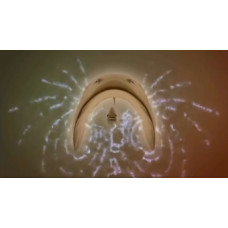Electrical perception organs are a cluster of sensitive cells (electroreceptors) that perceive magnetic and electric fields. They are located mainly on and around the head, less frequently on the gel surface. Electroreceptors responding to a potential difference of 0.01 V/cm, allow fish to orient themselves in space and localize prey, perceiving muscle potentials arising from respiratory movements of fish. Fish are able to perceive the magnetic field of the Earth, which allows many fish to feel the approach of an earthquake in 6-8 hours, sometimes 24 hours at a distance of up to 2 thousand kilometers.
The sensation of electric field - electroreception - is inherent in many species of fish, not only those that can generate electric discharges themselves. Electrical signals are picked up by special pits on the surface of the body. These pits are filled with a gel-like substance that conducts electric current and contains electroreceptor cells that form synapses with neurons.
By the nature of the electrical impulses produced, fishes are divided into nonelectric (most fishes), weakly electric (mormyres, gymnarchs), and strongly electric (electric catfish, eel, ray).
Non-electric fish as a result of neuromuscular activity create weak electrical impulses of 100-200 microns. A common bioelectric field is formed in a school of fish, formed by the summed electric fields of individual individuals, which affects the behavior and orientation of fish. Non-electric fish (except cartilaginous fish, some sturgeons, catfish) do not have electroreceptors. They perceive electric current, which acts on other receptors and free nerve endings.
Weakly and strongly electric fish perceive electric fields using lateral line electroreceptors. Specialized electrical organs serve them for defense, attack on prey and orientation. They are paired, symmetrically located on the sides of the body structures consisting of plates assembled into columns. In stingrays, the electrical organs, which account for up to 25% of the body mass, resemble bee honeycombs. Each organ consists of approximately 600 vertical prisms with 6 facets. Each prism is formed by approximately 40 electric disk-shaped plates separated by a gelatinous connective tissue. Each prism is a separate electrical battery.
The nerve centers of the electrical organs in fish are the electrical lobes of the medulla oblongata and the spinal cord.

